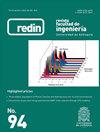采用三相流化床反应器的循环水养殖系统:除碳除氮
IF 0.5
Q3 ENGINEERING, MULTIDISCIPLINARY
Revista Facultad De Ingenieria-universidad De Antioquia
Pub Date : 2020-02-07
DOI:10.17533/udea.redin.20200264
引用次数: 3
摘要
本研究的核心目的是评价化养虹鳟鱼循环水养殖系统中有机物和氮的去除效率。该处理系统包括水力停留时间(HRT)为18和36 min的上流反应器、HRT为4.9和9.8 min的预过滤装置、HRT为5 ~ 11 min的三相气升流化床反应器、用于上流和流化床反应器出水过滤的颗粒装置(HRT为5.8和11.6 min),以及用于最终出水消毒的紫外线(UV)装置。在上流式反应器中,采用塑料材料作为支撑介质,在80 g/L恒定浓度下,采用有效粒径为1.30 mm的粒状沸石作为流化床反应器的载体。对生化需氧量(BOD)、化学需氧量(COD)、铵态氮、亚硝酸盐、硝酸盐和总氮的平均去除率分别为94.4、91.7、52.5、13.4、1.3和6.0%。虹鳟鱼养殖池的放水量为125 L,换水速率为125和250 L/h,无死亡记录;计算日增重分别为1.55和1.51 g/d,最终放养密度分别为20.87和20.58 kg/m3。结果表明,该系统具有发展硝化过程的能力,使水质特征保持在虹鳟鱼养殖的推荐值范围内,但由于亚硝酸盐和总氮的去除率适中,由于反硝化过程较弱,不能有效去除总氮。本文章由计算机程序翻译,如有差异,请以英文原文为准。
Recirculating aquaculture system with three phase fluidized bed reactor: Carbon and nitrogen removal
The core objective of the study was to evaluate the organic matter and nitrogen removal efficiency in a recirculating aquaculture system for the intensive laboratory-bred rainbow trout. The treatment system consisted of an upflow reactor which operated at a hydraulic retention time (HRT) of 18 and 36 min, a pre-filtration unit with HRT of 4.9 and 9.8 min, a three-phase airlift fluidized bed reactor operated at HRT between 5 and 11 min, a granular unit for the upflow and the fluidized bed reactors effluents filtration with 5.8 and 11.6 min as HRT, and an ultraviolet (UV) unit for the final effluent disinfection. A plastic material was used as support media in the upflow reactor, and granular zeolite with an effective size of 1.30 mm in an 80 g/L constant concentration was used as a carrier for the fluidized bed reactor. Average removal efficiencies of biochemical oxygen demand (BOD) chemical oxygen demand (COD), ammonium, nitrite, nitrate, and total nitrogen were 94.4, 91.7, 52.5, 13.4, 1.3 and 6.0% respectively. In the rainbow trout rearing tanks, there was a water volume of 125 L and water exchange rates of 125 and 250 L/h, there were no registered mortalities; the calculated daily weight gains were 1.55 and 1.51 g/day and the final stocking densities were respectively 20.87 and 20.58 kg/m3. The results suggested that the system had the capability to develop a nitrification process for maintaining water quality characteristics within the recommended values for rainbow trout farming, but total nitrogen was not effectively removed due to the weak denitrification process, since there were modest values of nitrite and overall nitrogen removal.
求助全文
通过发布文献求助,成功后即可免费获取论文全文。
去求助
来源期刊
CiteScore
2.00
自引率
0.00%
发文量
27
审稿时长
2 months
期刊介绍:
Revista Facultad de Ingenieria started in 1984 and is a publication of the School of Engineering at the University of Antioquia.
The main objective of the journal is to promote and stimulate the publishing of national and international scientific research results. The journal publishes original articles, resulting from scientific research, experimental and or simulation studies in engineering sciences, technology, and similar disciplines (Electronics, Telecommunications, Bioengineering, Biotechnology, Electrical, Computer Science, Mechanical, Chemical, Environmental, Materials, Sanitary, Civil and Industrial Engineering).
In exceptional cases, the journal will publish insightful articles related to current important subjects, or revision articles representing a significant contribution to the contextualization of the state of the art in a known relevant topic. Case reports will only be published when those cases are related to studies in which the validity of a methodology is being proven for the first time, or when a significant contribution to the knowledge of an unexplored system can be proven.
All published articles have undergone a peer review process, carried out by experts recognized for their knowledge and contributions to the relevant field.
To adapt the Journal to international standards and to promote the visibility of the published articles; and therefore, to have a greater impact in the global academic community, after November 1st 2013, the journal will accept only manuscripts written in English for reviewing and publication.
Revista Facultad de Ingeniería –redin is entirely financed by University of Antioquia
Since 2015, every article accepted for publication in the journal is assigned a DOI number.

 求助内容:
求助内容: 应助结果提醒方式:
应助结果提醒方式:


